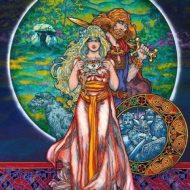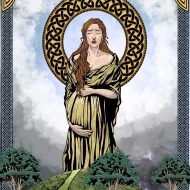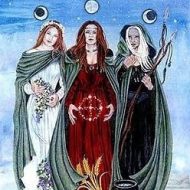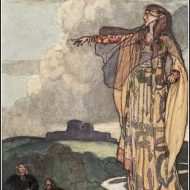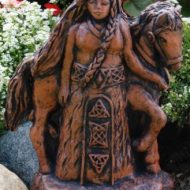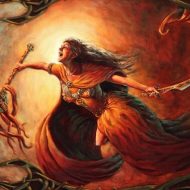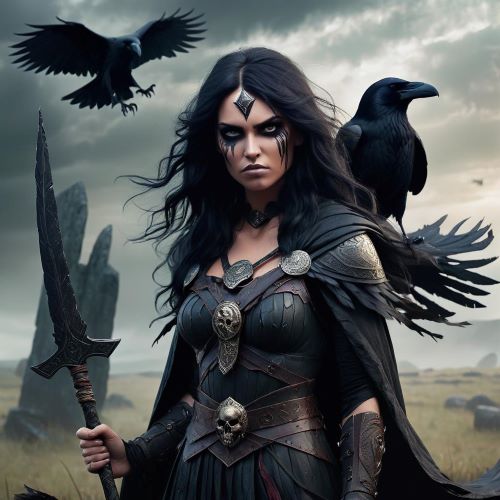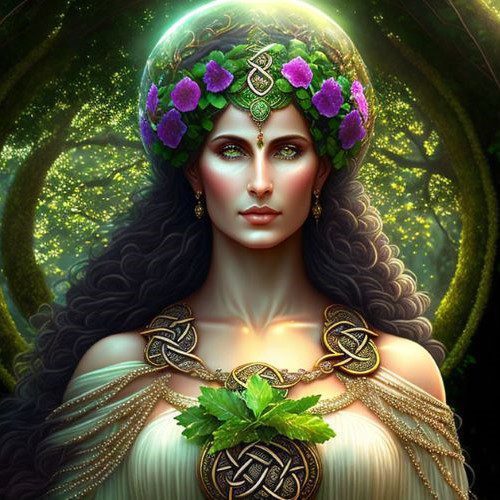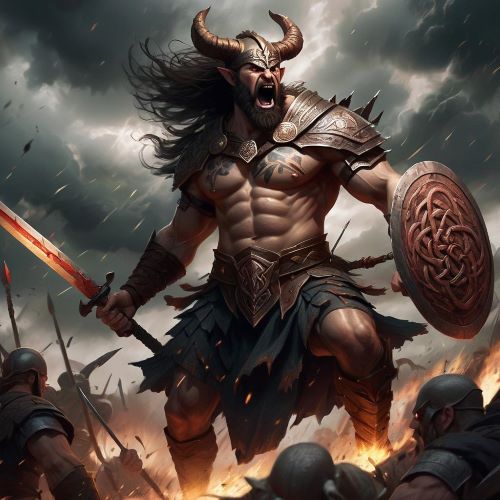Macha : The Warrior Goddess
Listen
At a glance
| Description | |
|---|---|
| Origin | Celtic Mythology |
| Classification | Gods |
| Family Members | Badb, Nemain (Sisters), Nuada (Husband) |
| Region | Ireland, Northern Ireland |
| Associated With | War, Horses, Fertility |
Macha
Introduction
Macha, a compelling figure entrenched in Celtic mythology, is frequently linked to themes of sovereignty, war, and horses. Within the rich tapestry of Celtic lore, she assumes a prominent role, embodying the qualities associated with war, fertility, and royalty. Various incarnations of the name Macha appear in Irish mythology and folklore, all tracing their origins back to the same goddess. Emerging from the mist-laden landscapes of ancient Ireland, where emerald hills reach for stormy skies, Macha stands as a figure of profound power and duality. As the formidable goddess of war and earth, she holds sway over both battlegrounds and fertile plains, seamlessly blending grace and fury in her dominion.
Physical Traits
In certain myths, she is described as surpassing the swiftness of a horse, embodying notions of pure speed and freedom. Her association with horses goes beyond mere symbolism; it signifies her pivotal role as a bestower of abundance and prosperity, ensuring the fertility of the land and the well-being of its inhabitants.
Descriptions of Macha frequently portray her as a woman of stunning beauty, characterized by piercing blue eyes mirroring the depths of the Irish sea and hair resembling spun gold kissed by fire. Despite her slender frame, she conceals a formidable strength, forged through years of battle and the unyielding rhythms of the earth. Draped in robes flowing like twilight, she moves with the agility of a wild creature – a mere whisper one moment, a whirlwind the next.
In certain depictions, Macha adorns herself with the feathers of ravens, creatures that accompany her on the battlefield, serving as a reminder to mortals of her connection to the otherworldly realms. The symbolism of horses in her tales extends to instances where she assumes an equine form, emblematic of the wild and untamed aspects of nature. This dual representation in her physical form serves to underscore the multifaceted nature of Macha, hinting at a complexity that transcends mere outward appearances.
Family
Macha is recognized as one of the three sisters collectively known as ‘the three Morrígna.’ Frequently associated with the Morrigan, a triple goddess that constitutes a triad featuring Badb, Macha, and Anand (also known as Nemain), she plays a crucial role in the intricate tapestry of Celtic mythology. The familial connections of Macha are intricate, intertwining with the essence of Celtic lore. Within the powerful triad of warrior goddesses known as the Morrígan, Macha stands alongside Badb and Nemain, forming a trio of formidable figures. While some scholars argue that these goddesses are facets of a single, multifaceted entity, others perceive them as distinct sisters.
Macha’s familial bonds extend beyond the divine realm to her connection with Crunniuc, a legendary charioteer. Their love story is characterized by passion and tempestuousness, resulting in the creation of Emain Macha, a royal stronghold in Ulster named in honor of the goddess herself. Additionally, Macha is sometimes recognized as the wife of Nuada, a king of the Tuatha Dé Danann, emphasizing her ties to both royalty and leadership within the Celtic pantheon.
Other names
Macha defies confinement within a singular identity, with instances where she is denoted as “Macha of the Red Hair,” underscoring her fiery and passionate nature. The diversity of names attributed to Macha further emphasizes her multifaceted character. Recognized by various titles, including Dana and Badb, translating to “Crow” or “Raven,” she is also acknowledged as the daughter of Midir of Brí Léith. In the Dindsenchas, Macha takes on the name Grian Banchure, signifying the “Sun of Womanfolk.”
As a goddess of remarkable versatility, Macha wears many masks, each name bestowed upon her revealing a unique facet of her being. Referred to as the “Raven of Battles,” she stands as a harbinger of both death and victory. In the role of the “Great Queen” of the land, she ensures its prosperity and fertility. For the warriors of Ulster, she adopts the persona of “Eriu,” serving as their sovereign goddess and protector of their land and legacy. Each name echoes a different aspect of her power, providing glimpses into the profound depths of her existence.
Powers and Abilities
Macha stands as a revered figure, celebrated for her unwavering prowess as a fierce and fearless warrior, embodying the valor and strategic acumen reminiscent of ancient Celtic warriors. In her martial endeavors, Macha becomes a symbol of the indomitable strength and resilience inherent in the Celtic people. Beyond her martial persona, this multifaceted goddess is intricately tied to fertility and horses, adding layers to her character.
One of the most renowned tales surrounding Macha centers on her extraordinary speed. Engaging in a race against the horses of the Ulster king while heavily pregnant, she emerges victorious, a testament not only to her physical prowess but also to her profound connection with the untamed forces of nature. Macha’s transformative ability, assuming the form of a horse, showcases her shapeshifting prowess, a trait shared among numerous Celtic deities. This capacity for transformation symbolizes the cyclical nature of existence, weaving together themes of life, death, and rebirth, further accentuating Macha’s alignment with the natural order.
As a force of nature, Macha commands the fury of storms, unleashing lightning and hail upon her adversaries. Swift and unseen, she effortlessly morphs into a raven or horse with a mere thought, traversing the battlefield. Her penetrating gaze delves into the hearts of men, laying bare their deepest fears and desires. Yet, Macha’s power extends beyond mere destruction; her unparalleled skill in warfare guides armies to victory, marked by both cunning strategies and unwavering courage. Additionally, she holds sway over the lifeblood of the land, ensuring bountiful harvests and nurturing the earth’s abundance. In Macha’s multifaceted nature, the realms of war, fertility, and transformation converge, painting a vivid portrait of a goddess whose influence echoes across the tapestry of Celtic mythology.
Modern Day Influence
Macha’s enduring impact extends into contemporary Irish culture, where she finds representation in diverse forms such as art, literature, and festivals celebrating Celtic heritage. While the portrayals of Macha may vary, a consistent theme persists – one of indomitable strength and a profound connection to the land and horses. This representation serves as a cultural bridge, linking modern interpretations with the ancient tales that feature Macha.
Delving into the essence of Macha’s presence in Celtic mythology, her story reveals an intrinsic understanding of the importance of balance and harmony within the cycles of life. This narrative underscores the reverence and respect that the ancient Celts held for the Earth and its abundant blessings. Moreover, Macha’s association with fertility and the land resonates with contemporary environmental concerns, fostering a renewed appreciation for nature and its cyclical rhythms.
In the artistic realm, creators draw inspiration from Macha, infusing her essence into their works. This creative integration contributes significantly to the ongoing evolution of Celtic mythology within the collective consciousness. As Macha continues to weave her influence through various cultural expressions, she serves as a reminder of the timeless wisdom embedded in Celtic traditions, encouraging a deeper connection with the natural world and an acknowledgment of its enduring significance.
Related Images
Frequently Asked Questions
What is lorem Ipsum?
I am text block. Click edit button to change this text. Lorem ipsum dolor sit amet, consectetur adipiscing elit. Ut elit tellus, luctus nec ullamcorper mattis, pulvinar dapibus leo.
What is lorem Ipsum?
I am text block. Click edit button to change this text. Lorem ipsum dolor sit amet, consectetur adipiscing elit. Ut elit tellus, luctus nec ullamcorper mattis, pulvinar dapibus leo.
What is lorem Ipsum?
I am text block. Click edit button to change this text. Lorem ipsum dolor sit amet, consectetur adipiscing elit. Ut elit tellus, luctus nec ullamcorper mattis, pulvinar dapibus leo.
What is lorem Ipsum?
I am text block. Click edit button to change this text. Lorem ipsum dolor sit amet, consectetur adipiscing elit. Ut elit tellus, luctus nec ullamcorper mattis, pulvinar dapibus leo.
What is lorem Ipsum?
I am text block. Click edit button to change this text. Lorem ipsum dolor sit amet, consectetur adipiscing elit. Ut elit tellus, luctus nec ullamcorper mattis, pulvinar dapibus leo.

